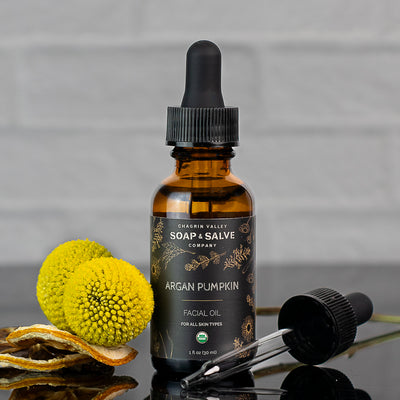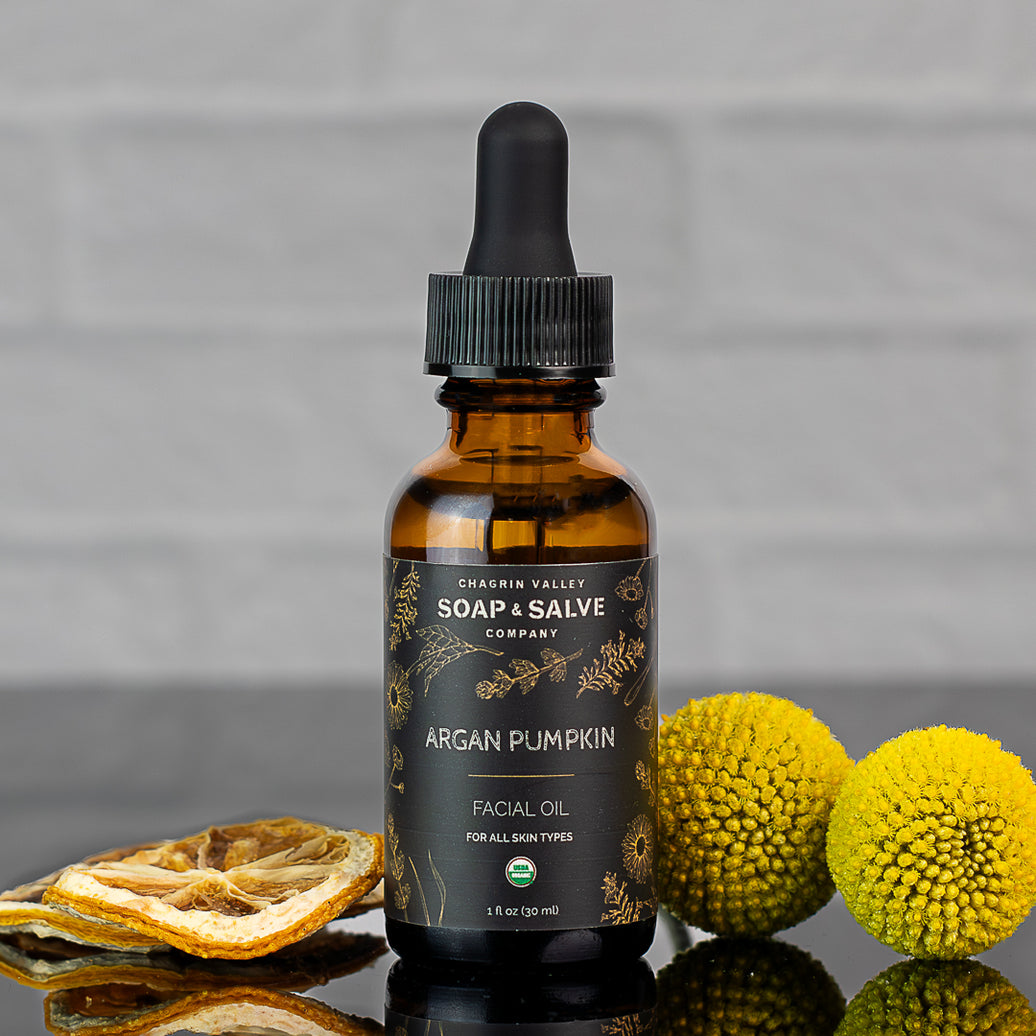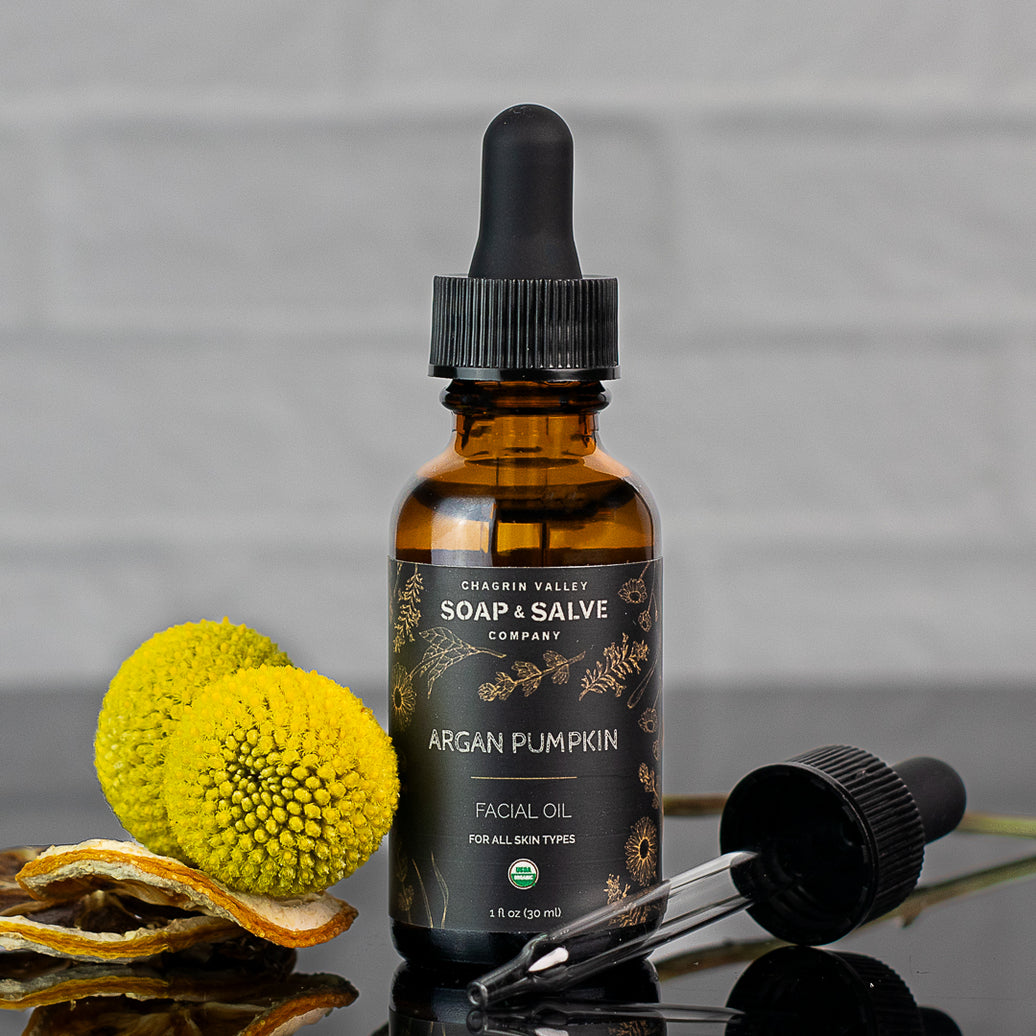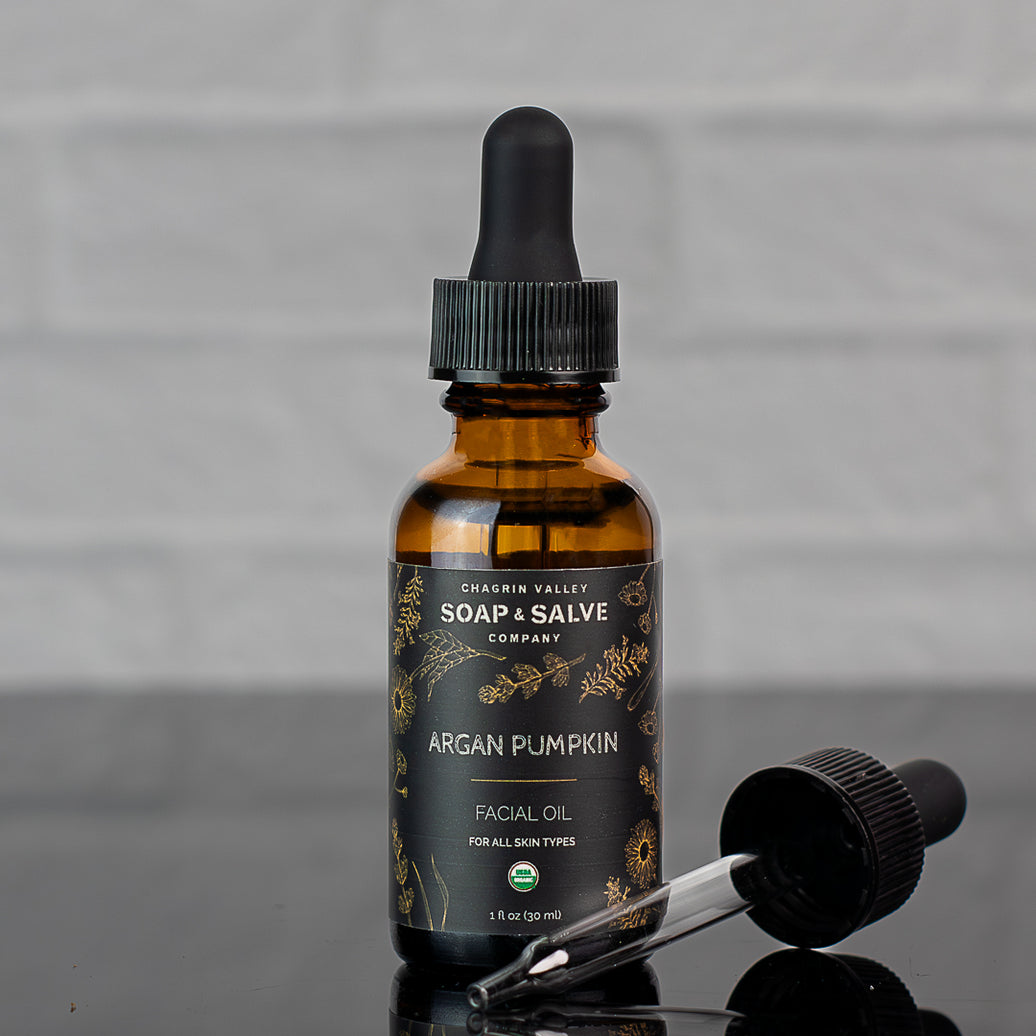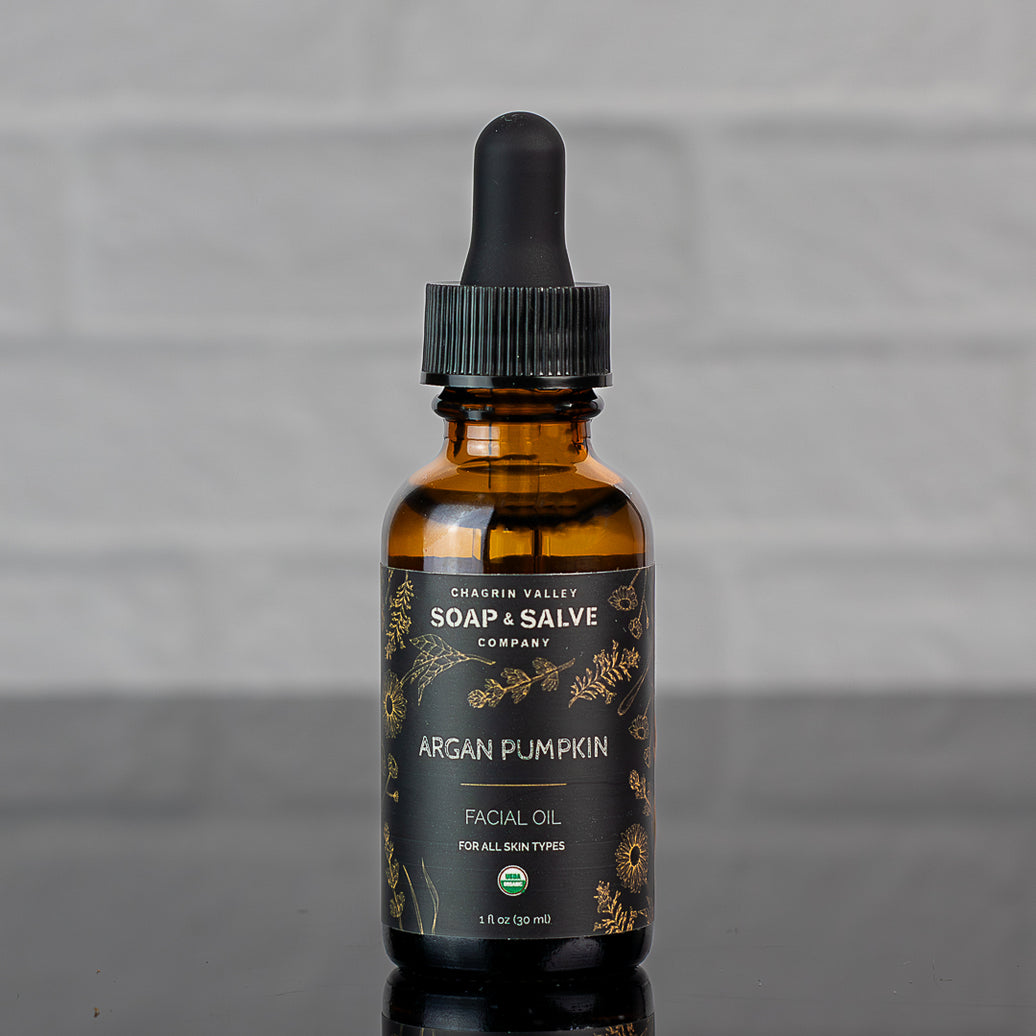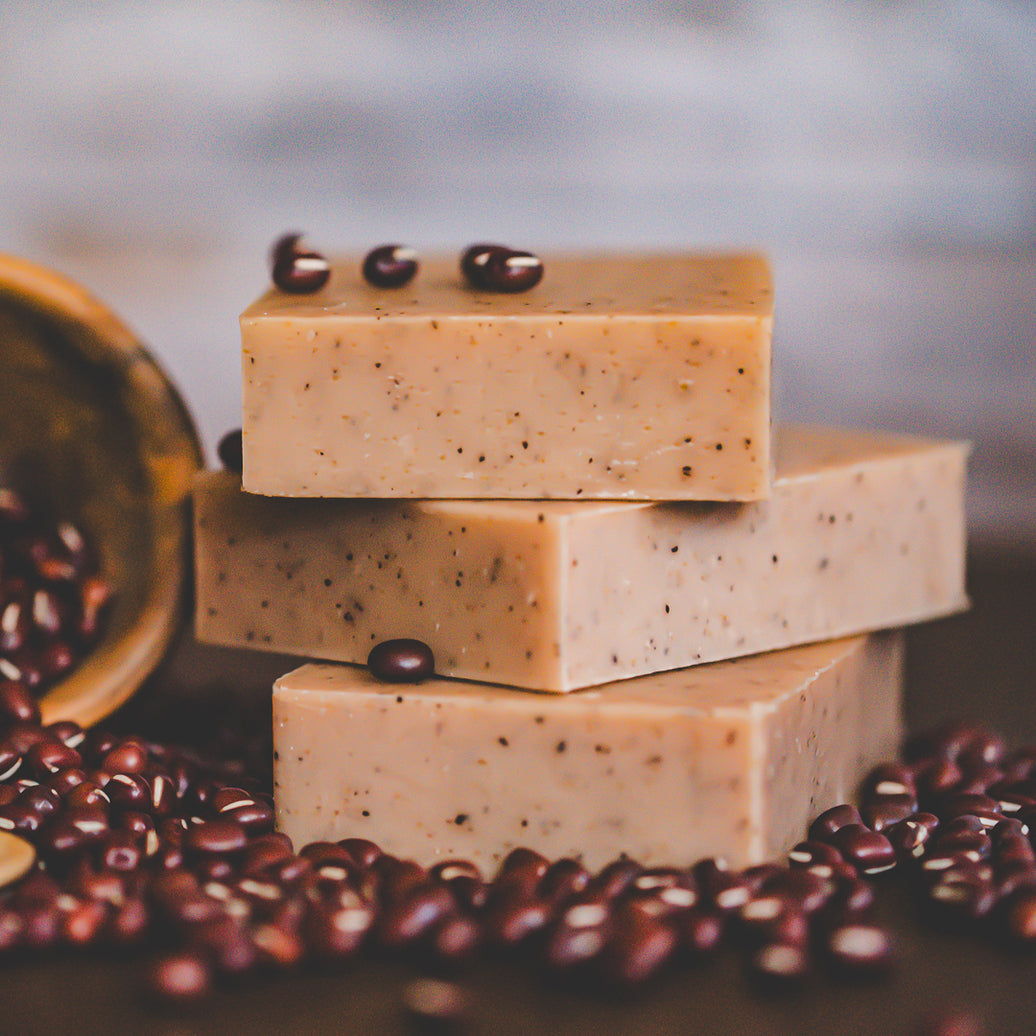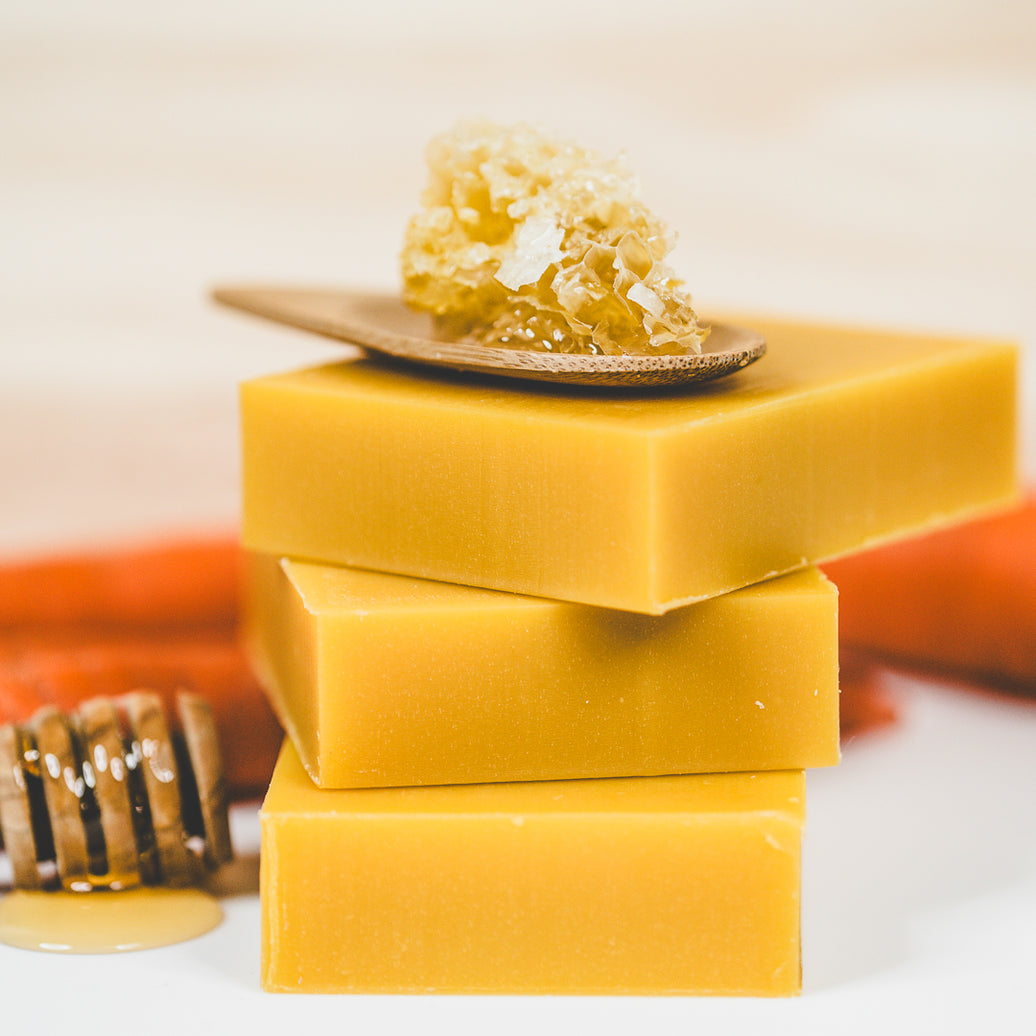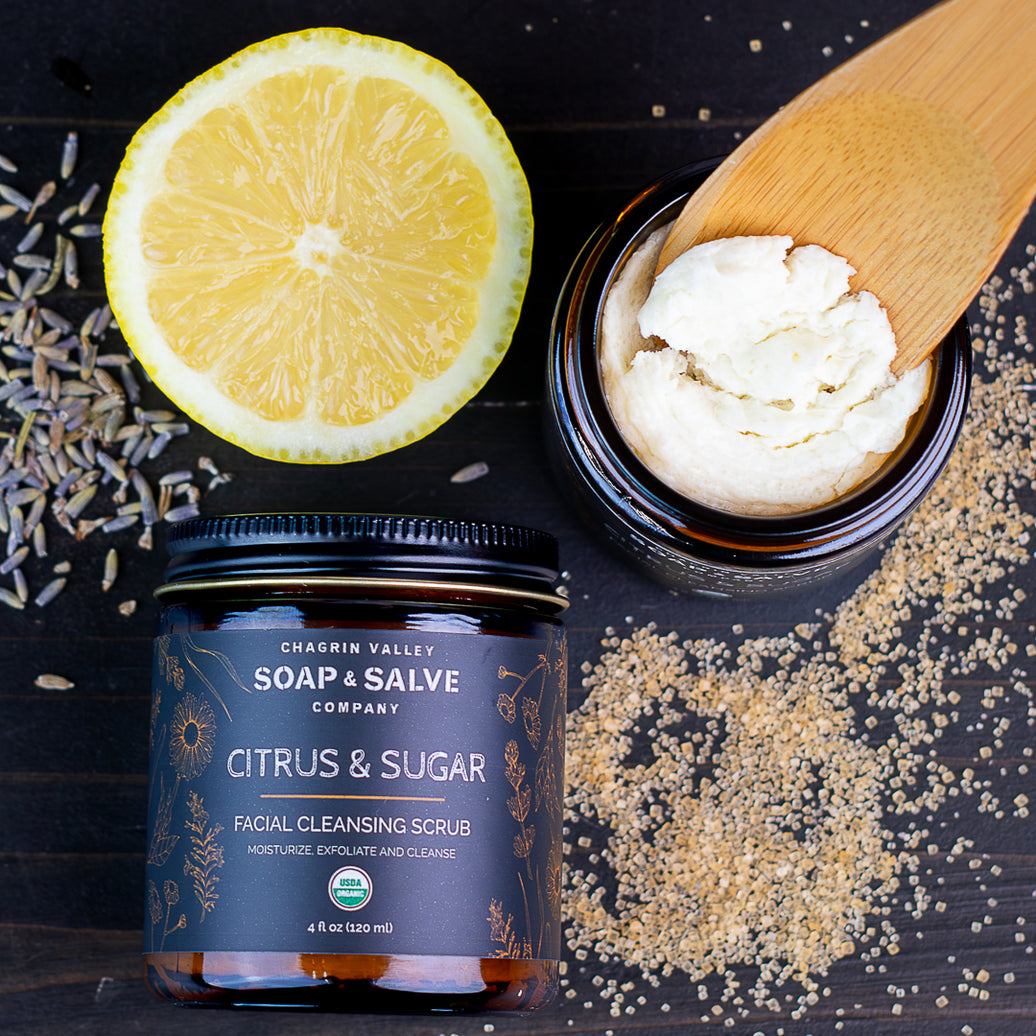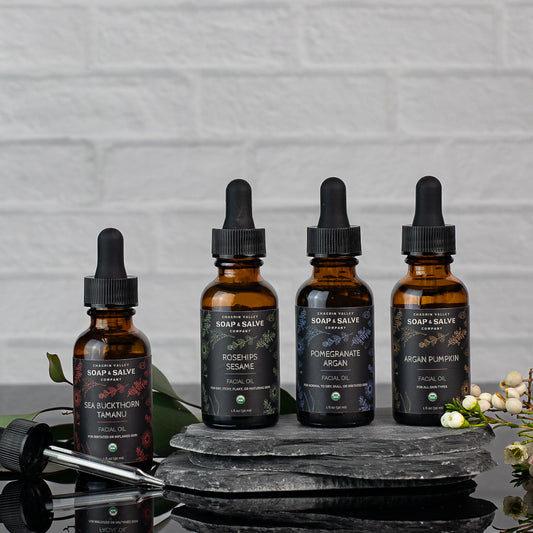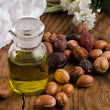
Gesichtsöl: Argan-Kürbis
Gesichtsöl: Argan-Kürbis
Tief nährende Öle wie Argan-, Kürbiskern-, Jojoba- und mit Pflanzenstoffen angereicherte Sonnenblumenöle helfen dabei, das gesunde Gleichgewicht normaler oder fettiger Haut wiederherzustellen, indem sie die natürliche Ölproduktion regulieren.
- Out Of Stock






Product Overview
Good For: All Skin Types
Our lightest face oil, the Argan Pumpkin is great for skin that is sometimes shiny and sometimes needs moisture, thus needs help balancing oil production.
Proper hydration is key to retaining a healthy glow. The most basic function of a facial oil is to hydrate and soften the skin by preventing water loss.
People with oily skin are often told to use oil-free moisturizers with harsh ingredients in an attempt to get rid of oily shine. Harsh ingredients can strip the skin of its natural oils which triggers the skin to overcompensate by producing even more oil creating a vicious cycle. A wholesome face oil can actually help balance skin oil production.
This luxurious blend of unrefined organic oils and soothing botanicals is formulated for all skin types.
Argan Oil is prized for its ability to improve the quality of skin. Rich in vitamin E, natural squalene, phytosterols and essential fatty acids, it can help reduce the appearance of wrinkles and fine lines. It contains natural anti-inflammatory agents that help calm inflamed skin and sebum regulating properties that help reduce the appearance of blemishes.
Pumpkin Seed Oil is a highly nourishing and emollient oil rich in vitamin E, a powerful antioxidant. Rich in essential fatty acids that regulate skin oil (sebum) production, it is great for both oily/acne-prone skin and dry damaged skin. It helps combat fine facial lines and may be helpful for inflamed skin.
Tamanu Oil is readily absorbed into the skin, helps improve the appearance of scars, and encourages healthy skin growth to aid in healing skin conditions. Tamanu oil is a remarkable topical healing agent with skin healing, antineuralgic, anti-inflammatory, antimicrobial, antibiotic, and antioxidant properties. The oil has been well researched, and the evidence of its ability to heal damaged skin is quite impressive. Tamanu is a costly oil. It takes 20 pounds of Tamanu fruit, the amount that one tree produces annually, to yield just ONE pound of oil!
Jojoba Oil closely resembles our own skin sebum and is considered nature's most effective natural moisturizer. It is so great for balancing oil production that it actually helps your skin find its own natural balance. It penetrates the skin easily, has anti-inflammatory actions, and can be used on oily and acne-prone skin. It is great for maturing skin and is gentle enough for sensitive skin.
Sunflower Oil, one of the most moisturizing vegetable oils, is easily absorbed and can be used on all skin types. It is rich in essential fatty acids and vitamin E making it especially helpful for dry or delicate skin. Its low comedogenic score means that it is less likely to block pores which could lead to blemishes.
The sunflower oil we use in our Argan Pumpkin Face Oil is infused with soothing and healing organic botanicals.
All Natural, Certified Organic, Vegan, Cruelty-Free, Non-GMO
Why should you use a facial oil? Scroll down a bit and read the FAQ to the right!
Packaged in a 1 oz. recyclable glass bottle with a glass pipette dropper.
How To Use
The Best Way to Apply a Face Oil
Less is More
For those who have tried facial oils but do not like them, often an incorrect application method is the problem. Since facial oils are very concentrated, a little goes a very long way and less is usually better than more.
If your skin feels oily hours after application, you should reconsider your technique.
Can a face oil replace your moisturizer? For some yes, but for others maybe not. If you have very dry or maturing skin a face oil alone may not contain enough of the "heavier" ingredients found in an organic oil-based moisturizing cream. The two products play different moisturizing roles and support each other.
For my 70 year old facial skin, a face oil alone is enough during summer months but not during the drying winters. If you are going to use both, apply the facial oil first and allow a few minutes for it to absorb before apply your face cream.
Is Your Face Ready?
The best way to apply facial moisturizers is on freshly cleaned, warm and damp (not wet) skin. Clean skin allows oils to better penetrate deep layers and stop leftover makeup from clogging pores.
Creams and oils work best with a little damp moisture. Facial oils are better able to lock in moisture when the skin is more pliable after a warm wash and damp skin also ensures that the oils spread evenly and absorb effectively into your skin leading to more hydrated, plumper skin.
Note that your skin should not be wet, just a bit moist, or the skin will be unable to hold the oil. Remember that oil and water do not mix!
How Much to Use
Again, facial oils are very concentrated, so start slowly. The key is to use them sparingly.
The recommended amount for your décolleté, neck, and face is about 4 to 6 drops. If doing your face only, you need about 2 to 3 drops of oil per treatment. If your skin is extra dry a couple more drops may be helpful. Just don’t overdo it. This might appear to be a very small amount but start out small, you can always add more.
Application Technique
Now that your skin is ready you need to choose an application method.
While many people have their own special technique for applying face oil, here are two favorites. Always be sure that your hands are clean and remember to begin with clean, damp skin.
Dropper Method
 We suggest applying our facial oil directly to your skin with the dropper. Placing the oils on your hands first will probably give you soft hands, but you want to get the most benefit for face!
We suggest applying our facial oil directly to your skin with the dropper. Placing the oils on your hands first will probably give you soft hands, but you want to get the most benefit for face!
While it may be called a facial oil, the sensitive skin on your neck is especially prone to signs of aging or dryness.
Begin with only a drop on each cheek, one drop on your neck, one on your décolleté, and one on your forehead, focusing on problem areas (remember you can always add more if needed).
If you choose to do your face only, place one drop on each cheek and one on your forehead. If you have an oily T-zone, but dry flaky cheeks, limit your facial oil application to dry problem areas only.
Patting the oil onto the skin with your fingertips is often thought to be more effective than rubbing the oils into your skin. Patting can aid in oil absorption and nourish deeper skin layers. But using a gentle "rub" in sections will also work, especially if time is a factor.
EYES: Take extra care around the eye area since rubbing or pulling that delicate skin may help encourage those annoying eye wrinkles. My eye technique:
- I place less than pea-sized amount of oil on my left ring finger to use a my "dipping pot".
- Then I use the ring finger from the other hand to dab small amounts of oil gently around the eyes.
- Using a dabbing motion, I gently smooth the oil into the skin, beginning at the inner corner of the eye to the outer corner of the eye.
When applying moisturizer to your neck or décolleté, massage in an upward soft stroking motion, until completely absorbed.
A face oil is a great product to use with facial massage. Using small circular strokes in an upward, outward motion, massage slowly and gently with your oily fingertips until most of the oil has been absorbed. The gentle massage will also give your skin a nice circulation boost and can help with lymphatic drainage.
TIPS:
- Any oil left on your fingers can be used anywhere that needs some extra TLC, like the ends of your hair or your cuticles.
- If your skin is very dry it may need an additional application during the day. We suggest taking a tiny spray bottle filled with clean water to give your face a quick mist before reapplying.
Palm Method
While your skin is still slightly damp, place a few drops of face oil in the palm of one hand and then warm the oil by gently rubbing the palms of your hands together. Then press both your palms onto your face with firm but gentle pressure and hold for a few seconds. Then gently massage until it feels absorbed. Some believe that this warming process helps to better activate all the goodness in your oil and enhance absorption.
When To Use a Facial Oil
It is usually suggested that a facial oil be used in the morning. If your skin is extra thirsty, apply the face oil and allow a few minutes for it to absorb. Then use your natural cream moisturizer as usual for extra hydration.
There is a debate as to whether you should apply moisturizers at night. You need to pay attention to YOUR skin!
One school of thought is that you should not moisturize at night. While you sleep skin cells are hard at work naturally repairing, regenerating, balancing oil production, and flushing out impurities.
Applying moisturizers may prevent your skin from breathing, interfere with the skin’s natural regenerative activities, and may cause your skin to become dependent on moisturizers.
The other school of thought is that since cell repair and regeneration is higher at night, skin loses more moisture and needs the extra moisture. Also, since the skin’s ability to absorb ingredients peaks at night, your skin may be able to better absorb the nourishing, moisturizing ingredients.
When applying a face oil at night, we recommend applying the oil at least 20 to 30 minutes before going to bed. The oil needs time to soak into your skin, rather than into your pillow.
If you choose to moisturize day and night, a light facial oil may be better than a heavy cream. Just remember that your skin needs time to breathe. Using too much over time can make your skin lazy. Over moisturizing signals your own sebaceous (oil) glands to slow down natural moisture production, which can result in chronic dry skin.
If you have very sensitive skin or are simply trying a new product for the first time, we always recommend doing a patch test.
For external use only. Discontinue use if irritation occurs. Best if used within 6 months of opening.
For more detailed information about face oils please read our blog, "What are Facial Oils and How to Use Them"

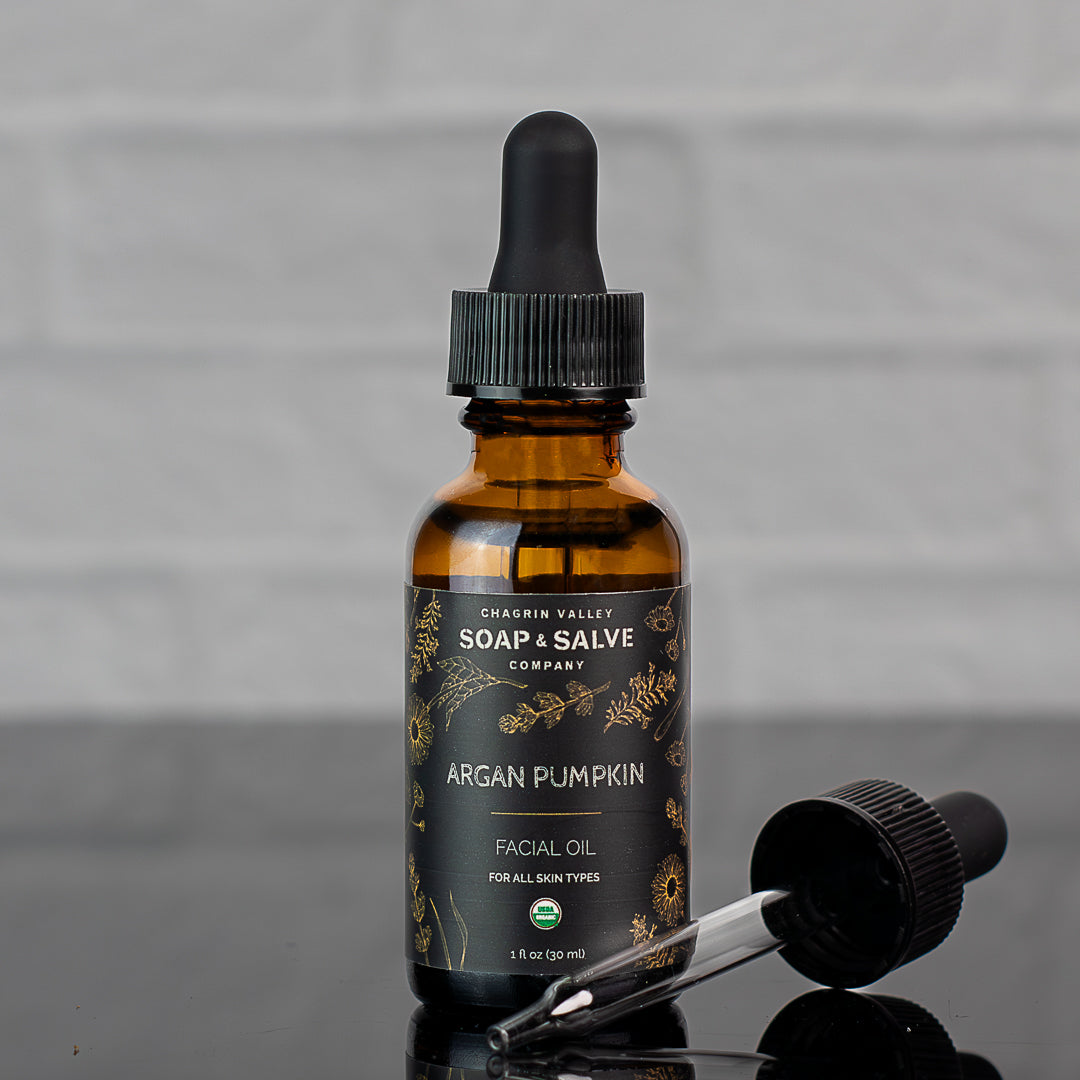
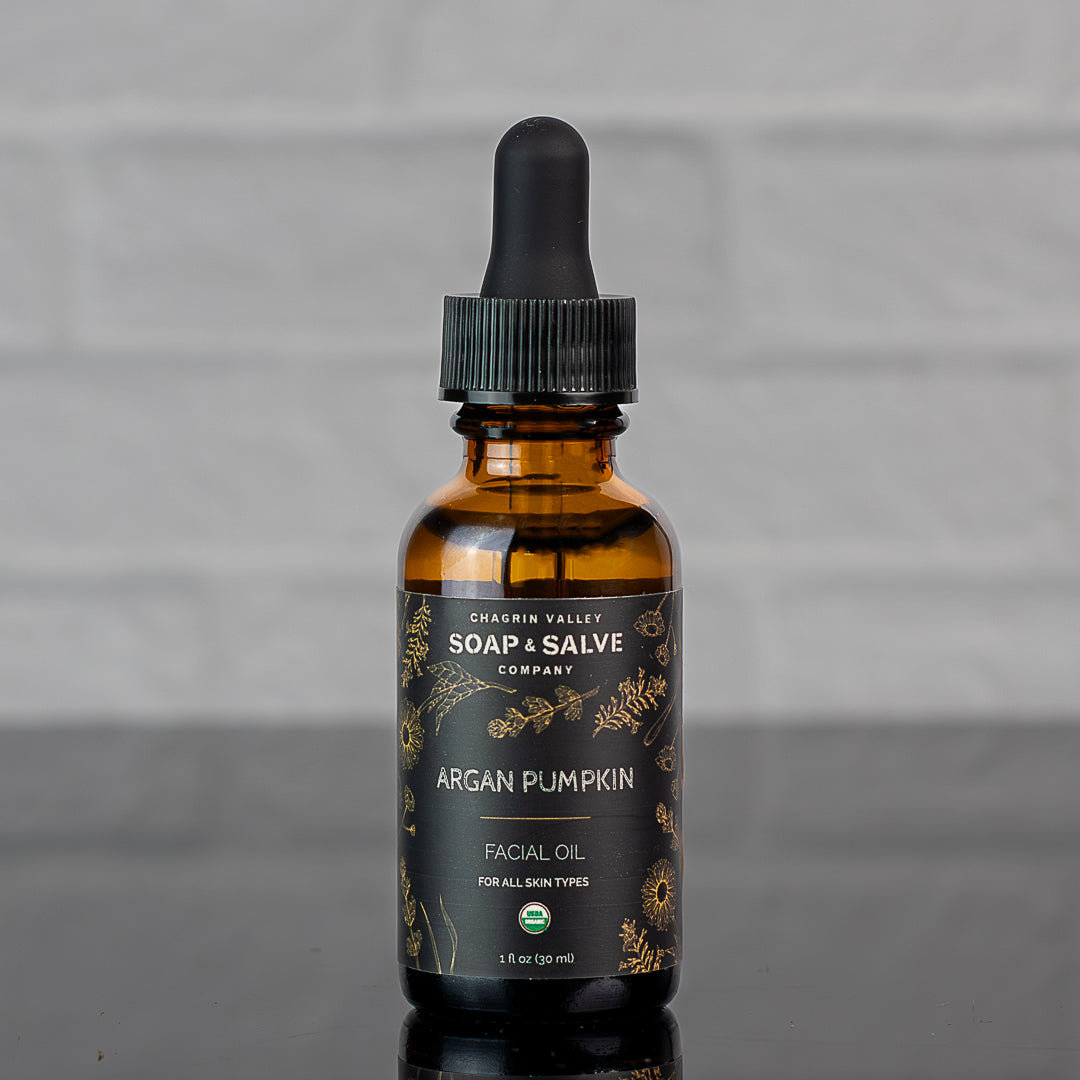
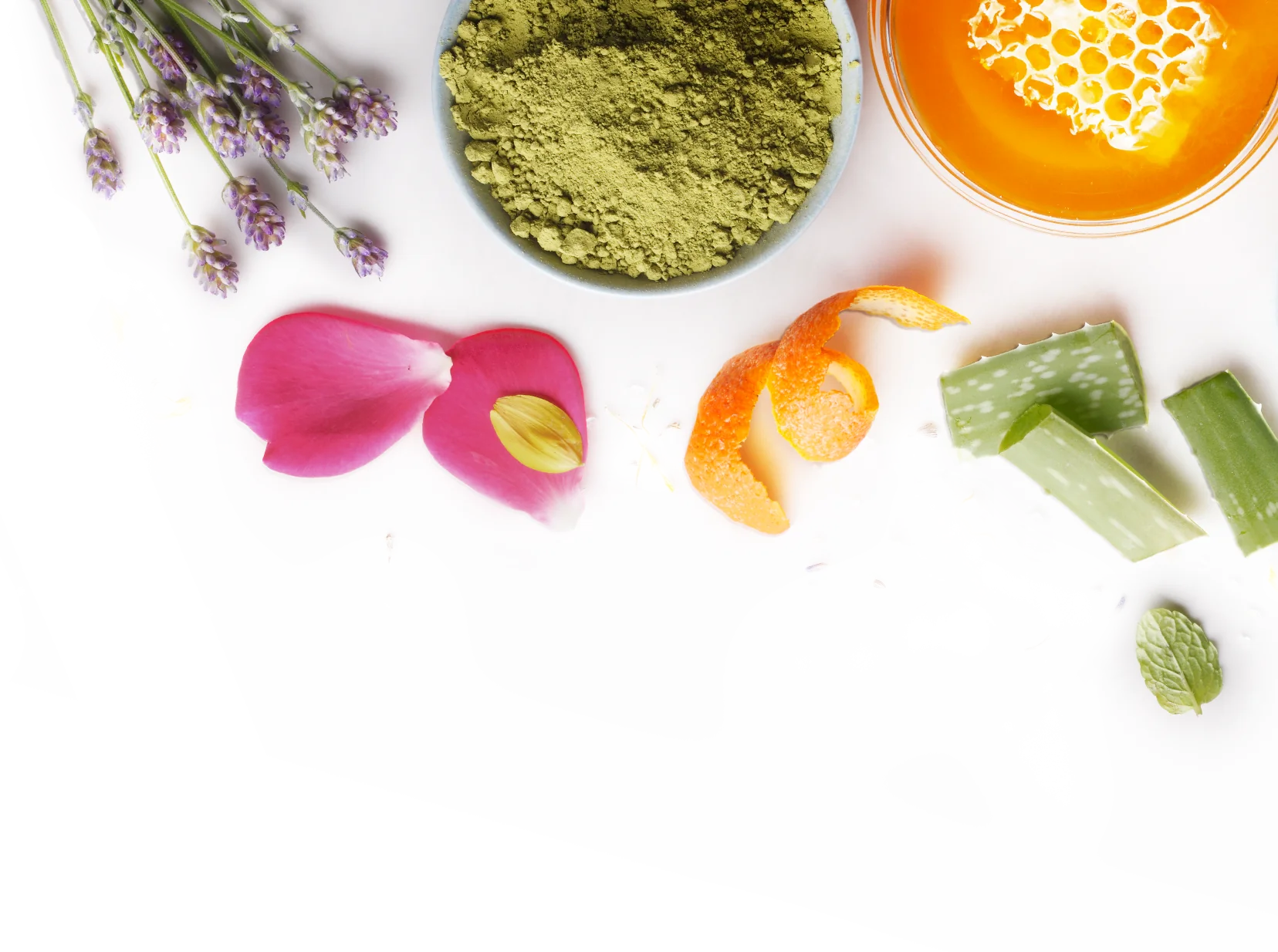
Wirksame Inhaltsstoffe zum Wohlfühlen
Das Ziel ist einfach: Nutzen Sie die Kraft und Einfachheit der Natur®, um Ihre Haut und Ihr Haar zu reinigen, zu beruhigen, zu heilen und zu schützen!
Unsere einzigartigen Formeln basieren auf feuchtigkeitsspendenden Ölen und Buttern, heilenden Pflanzenstoffen und reinen ätherischen Ölen. Wir wählen jede Zutat mit einem Ziel vor Augen: der bestmöglichen natürlichen Hautpflege für SIE!
Ausgewählte Zutaten


Organic Kürbiskernöl
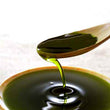
Organic Tamanu-Öl
All Ingredients:
Organic Sunflower Oil infused with Organic Botanicals Calendula, Plantain, Elder Flowers, Marshmallow Root, Mullein & St. John's Wort
Organic oils are unrefined and have not been bleached or deodorized. These oils retain their natural scent, color, and nutritional benefits.
Häufig gestellte Fragen
Was ist mein Hauttyp?
Ihre Haut ist so einzigartig wie Sie selbst.
Wenn Sie darüber nachdenken, ist Ihr Hauttyp nicht an allen Stellen Ihres Körpers derselbe.
Die Haut in Ihrem Gesicht unterscheidet sich von der Haut an Ihren Händen, die sich wiederum von der Haut auf Ihrem Rücken unterscheidet, die sich wiederum von der Haut an Ihren Füßen unterscheidet … usw.
Obwohl Ihr Hauttyp genetisch bedingt ist, wird er auch von anderen Faktoren beeinflusst und kann sich mit der Zeit verändern.
Bevor Sie Naturprodukte ausprobieren oder auf solche umsteigen, ist es ein guter Ausgangspunkt, Ihren Hauttyp zu kennen.
Es gibt im Allgemeinen fünf Typen gesunder Haut: normale, trockene, fettige, Mischhaut und empfindliche Haut.
NORMALE HAUT
Diese Haut ist ausgeglichen, weder zu trocken noch zu fettig. Sie hat eine regelmäßige Textur, keine Unreinheiten, ein sauberes, weiches Aussehen und benötigt keine besondere Pflege.
Fettige Haut
Fettige Haut entsteht durch übermäßige Talgproduktion, ein öliges Sekret der Talgdrüsen. Fettige Haut zieht mehr Schmutz und Staub an als trockene Haut und kann zu Mitessern, Akne und übermäßigem Glanz neigen. Sie tritt häufig bei Jugendlichen auf und wird oft mit Akne oder zu Unreinheiten neigender Haut in Verbindung gebracht.
TROCKENE HAUT
Bei manchen Menschen ist trockene Haut auf äußere Faktoren wie das Wetter, niedrige Luftfeuchtigkeit, Sonne oder heiße Duschen zurückzuführen und ist oft nur vorübergehend.
Bei anderen kann es jedoch ein lebenslanges Problem sein. Trockene Haut ist die Folge einer verminderten natürlichen Ölproduktion, die oft zu schuppiger und rauer Haut führt. Trockene, rissige Haut ist oft anfällig für Hauterkrankungen wie Ekzeme.
 EMPFINDLICHE HAUT
EMPFINDLICHE HAUT
Wirklich empfindliche Haut reagiert leicht auf äußere Reize. Die Haut ist oft empfindlich, dünn oder fein strukturiert, trocken und neigt zu allergischen Reaktionen.
Empfindliche Haut fühlt sich oft unangenehm an, spannt, ist gerötet oder juckt. Es ist zarte Haut, die viel Pflege braucht.
MISCHHAUT
Mischhaut ist genau das, wonach es klingt: Sie weist sowohl Merkmale trockener als auch fettiger Haut auf. Der fettreichere Bereich ist in der Regel die T-Zone (Stirn, Nase und Kinn), während die Haut an den Wangen normal oder trocken ist.
Weitere Informationen zum Hauttyp und Hilfe mit Produktempfehlungen für Ihre individuellen Bedürfnisse finden Sie in unserem Blog „ Was ist Ihr Hauttyp?“
View Answer Page
Warum sollte ich ÖL auf mein Gesicht auftragen?
Ob Sie sie nun „ Gesichtsöle“ oder „Gesichtsseren “ nennen , pflegende, unraffinierte Bio-Öle können die Gesichtshaut mit Feuchtigkeit versorgen, beruhigen und dabei helfen, ihr natürliches Gleichgewicht wiederherzustellen.
Mit zunehmendem Alter verliert unsere Haut ihre Fähigkeit, Feuchtigkeit zu speichern. Sie wird dünner und verliert an Elastizität. Zudem produziert sie weniger Fett und trocknet dadurch leichter aus. Dies kann feine Linien und Fältchen verstärken. Gesichtsöle können helfen, Wasserverlust vorzubeugen und die Haut prall zu halten.
 Anwendungshinweis: Tragen Sie das Gesichtsöl direkt nach dem Waschen der Haut und direkt vor jeder anderen Feuchtigkeitscreme auf, um das Wasser auf der Haut zu halten und die Feuchtigkeit einzuschließen.
Anwendungshinweis: Tragen Sie das Gesichtsöl direkt nach dem Waschen der Haut und direkt vor jeder anderen Feuchtigkeitscreme auf, um das Wasser auf der Haut zu halten und die Feuchtigkeit einzuschließen.
Viele Menschen, insbesondere mit fettiger oder zu Akne neigender Haut, scheuen ölbasierte Feuchtigkeitspflegeprodukte, doch sie können ein wichtiger Schritt in der täglichen Hautpflege sein. Ein Bio-Gesichtsöl hilft, den Feuchtigkeitsgehalt der Haut zu erhöhen und weiterem Feuchtigkeitsverlust vorzubeugen.
Fettige Haut
Wenn Sie fettige Haut haben, können pflegende Bio-Öle dabei helfen , den natürlichen Talg der Haut nachzuahmen, der wiederum Signale an die ölproduzierenden Zellen sendet, die sagen: „Hey, meine Haut ist mit Feuchtigkeit versorgt, also hör auf, Öl zu produzieren.“
Mit Produkten, die zum „Austrocknen“ fettiger Haut entwickelt wurden, Der Versuch, fettigen Glanz zu beseitigen, regt die Talgdrüsen zu einer erhöhten Talgproduktion an, was das Problem fettiger Haut nur verschlimmert. Eine gesunde Feuchtigkeitscreme hilft, die Talgproduktion der Haut auszugleichen.
Trockene Haut
Bei trockener Haut bildet ein Bio-Gesichtsöl aus unraffinierten Pflanzenölen eine schützende, aber atmungsaktive Barriere , die die Feuchtigkeitsverdunstung verlangsamt und so hilft, die Feuchtigkeit einzuschließen.
Gereizte Haut
Ein natürliches Gesichtsöl ist ideal für empfindliche und gereizte Haut. Manchmal kann allein ausreichende Feuchtigkeitszufuhr helfen, Entzündungen zu lindern und gerötete, gereizte Haut zu beruhigen.
Reife Haut
Besonders für Menschen mit reifer Haut (wie mich!) ist es wichtig, das Gesicht ausreichend mit Feuchtigkeit zu versorgen, um feinen Linien und Fältchen entgegenzuwirken. Mit zunehmendem Alter nimmt der natürliche Ölgehalt der Haut ab, die Haut trocknet leichter aus und Falten erscheinen tiefer. Ein pflegendes Öl beugt Wasserverlust vor und macht die Haut praller.
Wichtig ist, dass Sie die richtige Feuchtigkeitscreme verwenden.
Die pflegendsten Gesichtsöle sind solche aus unraffinierten, zertifizierten Bio-Pflanzenölen. Unraffinierte Öle werden entweder kaltgepresst oder expellergepresst.
Sie werden ohne Chemikalien und unter kontrollierten Temperaturbedingungen minimal verarbeitet, wodurch ein nährstoffreiches, hochwertiges Naturöl entsteht.
USDA-zertifiziertes Bio-Produkt bedeutet, dass die Pflanzenöle frei von synthetischen Zusatzstoffen, Pestiziden und Konservierungsmitteln sind.
Vermeiden Sie Produkte auf Erdölbasis, die Mineralöle enthalten, die Ihre Poren verstopfen und Ausbrüche verursachen.

Was sind natürliche Gesichtsöle?
Erstellen einer Gesichtspflegeroutine
Was ist ein Gesichtsreinigungsöl? Wie verwende ich es?
View Answer Page
Sind die Zutaten und Produkte von Chagrin Valley vom USDA als biologisch zertifiziert?
Chagrin Valley Soap & Salve ist ein USDA-zertifiziertes Bio-Unternehmen

Der wichtigste Aspekt eines jeden Unternehmens sind seine Kunden. In der heutigen Welt voller irreführender Behauptungen, falscher Werbung und schlichter Täuschung versuchen Verbraucher oft, die Wahrheit über Körperpflegeprodukte und deren Inhaltsstoffe herauszufinden.
- Wir möchten, dass unsere Kunden wissen, dass wir uns bei allem, was wir tun, der Transparenz verpflichtet fühlen.
- Wir möchten, dass unsere Kunden wissen, dass wir es ernst meinen, wenn wir „biologisch“ sagen .
- Wir sind davon überzeugt, dass sich unsere Kunden als USDA-zertifiziertes Bio-Unternehmen keine Gedanken darüber machen müssen, ob wir tatsächlich zertifizierte Bio-Zutaten verwenden oder ob unsere Bio-Produkte wirklich biologisch sind.
- Deshalb haben wir uns dazu entschieden, ein zertifiziertes Bio-Unternehmen zu sein und die strengen Standards einzuhalten, die für die Bio-Zertifizierung erforderlich sind.
Einige meiner Lieblingsprodukte werden mit Zutaten hergestellt, die es nicht als Bio-zertifizierte Produkte gibt. Warum? Derzeit gibt es keine Standards für Inhaltsstoffe, die speziell in der Körperpflegeindustrie verwendet werden. Die Bio-Zertifizierung von Körperpflegeprodukten basiert auf den Bio-Lebensmittelstandards des National Organic Program des US-Landwirtschaftsministeriums (USDA).
Da wir jedoch ein zertifizierter Bio-Betrieb sind, sind wir verpflichtet, nachzuweisen, dass auch unsere „nicht-biologischen Zutaten“ ohne den Einsatz von giftigen Pestiziden, gentechnisch veränderten Organismen (GVO), Klärschlamm oder Bestrahlung hergestellt wurden.

Warum sind wir ein zertifiziertes Bio-Unternehmen geworden?
Was bedeuten all die Bio-Siegel?
View Answer Page
Enthalten die natürlichen Hautpflegeprodukte von Chagrin Valley GVO?
Chagrin Valley Soap & Salve ist ein vom USDA zertifiziertes Bio-Unternehmen.
Wir sind verpflichtet, einen Nachweis vorzulegen, dass ALLE unsere Zutaten, auch unsere „nicht-biologischen Zutaten“, ohne den Einsatz von GVO hergestellt wurden.
Da das US-amerikanische National Organics Program die Verwendung genetischer Veränderungen in Produkten verbietet, die als biologisch zertifiziert werden sollen, ist der Kauf von Bio-Produkten eine gute Möglichkeit, Ihre Belastung durch GVO zu verringern.
Als gentechnisch veränderte Organismen werden alle Tiere, Pflanzen und Mikroorganismen bezeichnet, die im Labor genetisch verändert wurden. Man spricht auch von „Gentechnik“.
Lesen Sie mehr über „GVO-freie Hautpflege-Inhaltsstoffe“
View Answer Page
